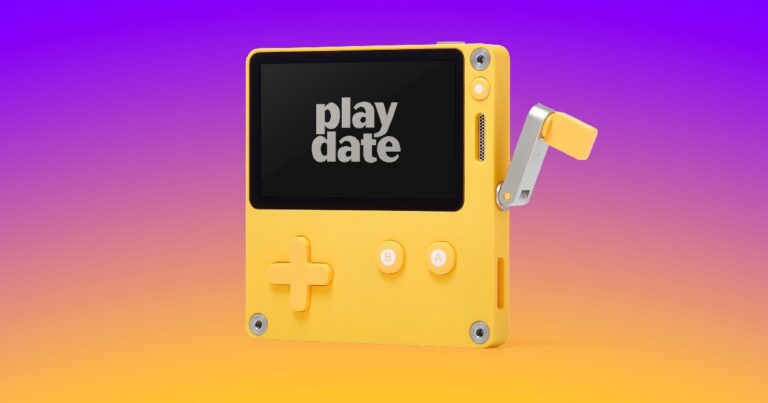Discover why you’ll fall in love with the Playdate and it’s crank-based joys, plus we check out Harrold Hallibut and the Brothers: A Tale of Two Sons remake.
With such a strong focus on horsepower and graphical fidelity, it’s becoming increasingly rare for gaming systems to embrace a bit of quirk. That’s exactly why I’m such a big fan of the Playdate. This palm-sized handheld device is not afraid to be a little different from head to toe. It’s design, execution and its delivery model are all wonderfully unconventional, but it also doesn’t hurt that it’s absolutely adorable.
A large part of that charm is a result of the unit’s size. The Playdate is seriously tiny 76 × 74 × 9 mm yellow square. The tiny form factor means the unit is incredibly lightweight and portable enough to easily slide into any pocket – just make sure you also pick up the custom cover (available on the Playdate store) to protect it from any nasty scratches. If you have large hands you might find the compact nature of the playdate slightly uncomfortable over long periods, but I personally never had an issue.
To their credit, Panic (the team behind the system) have done an impeccable job here. From top to bottom the Playdate is exceptionally well designed. Everything feels solid, the buttons have good give and the 400 × 240 1-bit screen is incredibly pretty to look at. But while you’ll likely fall in love with the device’s retro visual aesthetic in pure daylight, things become significantly hampered without a good light.
That’s because, love it or hate it, the Playdate is missing a backlight to help illuminate games in darker settings. While I can understand that extra cost that would have added to production, it’s hard not to see the move as an unfortunate oversight. There were many instances where I wanted to use my Playdate but couldn’t due to the lack of an appropriate light source and I would have to imagine I’m not alone.
That issue aside, the rest of the Playdate’s charm is all thanks to the system’s most unique element: it’s crank. You see, the Playdate doesn’t simply rely on the traditional d-pad and button setup. Instead, neatly tucked away on the unit’s right side is a small metal arm capable of delivering so much wonder. Unfurl it and not only will you be treated to a pleasant sound effect, but it opens the doors for the Playdate’s additional control method. At a base level it allows you easily scroll up and down through various system menus, but when it’s utilised a game level, things really shine.
Grand Tour Legends for example, is a simple bicycle racer in theory that amplifies its execution with intelligent crank use. The faster you turn the crank, the more your rider pedals, but doing so also comes at the expense of stamina. That means knowing when and how hard to pedal becomes critical for your success, as does leveraging declines in landscapes to help give you a bit of a reprieve.
Love Gaming?
Get the latest Gaming news, features, updates and giveaways straight to your inbox Learn more
A Balanced Brew on the other hand has you steering a moustachioed coffee-lover to his beloved coffee cart. Only issue is that he’s atop of a unicycle and has plenty of hills and obstacles in his way as you rotate the crank to build momentum without toppling over.
The biggest star of the show though is unquestionably Mars After Midnight, the long-awaited title from Lucas Pope, creator of Papers Please. Borrowing some of the foundations behind that classic indie, this time you find yourself on an off-colony community support centre on Mars, slowly cranking your peephole open to suss out whether you grant entry to a wild and whacky cast of alien characters, or slam it shut. It’s bonkers fun, but a perfect example of the type of experience the Playdate can offer.
Conversely, the Playdate is arguable at its weakest when the games don’t utilise the crank in any meaningful way, instead offering experiences that could be a dime-a-dozen on a range of other platforms. The system’s new Catalogue (its version of a shopfront) helps alleviate that with plenty of curation and recommendation to help guide you on the type of experience you’re after.
Many of the Playdate’s games are short-burst experiences or score-chasers, but they’re also reasonably priced – anywhere from USD $1 all the way to around $13 for meatier experiences. Even better is that when you set up your Playdate, you’re instantly entitled to the platform’s first season – granting your access to two new games every week for 12 weeks. It’s an incredibly interesting delivery system that builds anticipation each week as you wait to see what surprises await. Plus scoring 24 games is a great deal and there’s a great amount of variety at play. Sadly, there’s no word on whether there will be future seasons, but it’s an idea I’d certainly like to see return.
Unfortunately, as Australian’s, the playdate’s biggest hurdle is its price. At time of writing, after adding up the $199 USD price tag, as well as shipping and taxes, the Playdate will set you back around 375. For enthusiast consumer tech that’s not outlandish – the Analogue pocket currently retails for $219.99 USD. But when you realise that it would take less than $100 more to invest in a Nintendo Switch, it seems a little steep.
That’s not to say I don’t recommend the Playdate – far from it. It’s a well-designed, well-rounded and enjoyable system to utilise. If you can handle the price, you’re in store for one of the most unique video game systems in quite some time, and if you’re a hardcore gaming fan that should sound mighty enticing.
The Playdate is available for $199 from the Playdate website here.
Also out now…
Harrold Hallibut (PS5, Xbox Series X/S, PC)
If you’re looking for one of the most visually unique video games of 2024, you absolutely cannot go past Harrold Hallibut. This delightful narrative adventure will instantly wow you with its stunning stop-motion Claymation art style that has been lovingly placed on every element. Even after a few hours, I was consistently wowed with the level of effort present on every frame.
It’s the foundation behind Harrold Hallibut’s equally unique tale of a downtrodden man looking to escape a ark-like spaceship, 250 years after it got stuck at the bottom of the ocean trying to escape a cold war threat. Obviously, there’s a bit more to it than that, but it’s the little discoveries that add to much of this adventure’s appeal. It’s also the game’s primary driver, with actual gameplay being a little light (and slightly repetitive) outside of a handful of small tasks and dialogue exchanges.
The slower pace Harold Hallibut provides won’t gel for everybody, but it didn’t tarnish my enjoyment of the experience and is still an easy recommendation for those wanting to try something a little more zany.
Brothers: A Tale of Two Sons Remake (PS5, Xbox Series X/S, PC)
When Brothers: A Tale of Two Sons first launched back in 2013 it impressed with its unique control method: simultaneously managing two siblings with the one controller. 11 years down the road and this impressive remake takes the core foundations of what made Brothers such an engaging play.
As a result, the emotionally charged tale of Naia and Naiee trying to save their sick father is largely unchanged and still hits pretty hard. Utilising each siblings’ traits to carefully work your way through the game’s treacherous areas is still enjoyably tense, but the gorgeous new coat of paint simply amplifies things even more.
Sure the odd environment might look a little wonky, but I never minded considering how much cleat love and attention has been put into rejigging this classic adventure for a modern audience. Fans of the original will love the modern flourishes while this is undeniably the best way to play for any newcomers.
For more on this topic, follow the Gaming Observer.



































